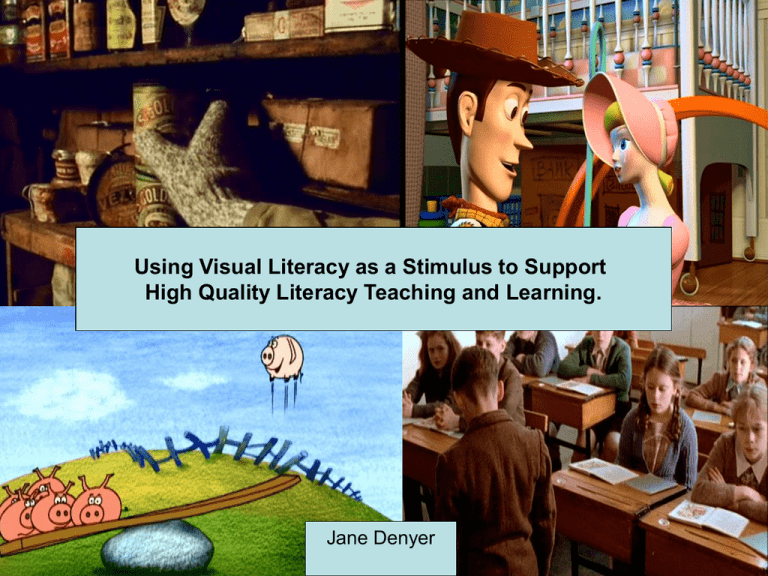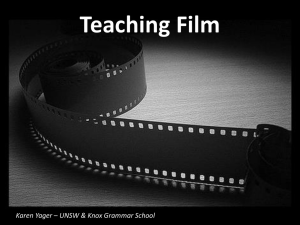Using Visual Literacy as a Stimulus to Support High Quality
advertisement

Using Visual Literacy as a Stimulus to Support High Quality Literacy Teaching and Learning. Jane Denyer Why do I use Visual Literacy? • • • • • • • • • • Engages Excites Inclusive Stimulates Supports Encourages talk Broadens perspectives Raises attainment Makes successful learners Because it personalises learning and follows children’s interests, making literacy learning accessible to all abilities How do I use Visual Literacy? • Every literacy unit I teach has a visual literacy element. • It integrates in ANY phase of teaching. • It is used as a stimulus, to develop learning and sometimes as an outcome. • I also plan 1 topic centred around film – last year year our topic was ‘Amazing Animation’, I have also done a topic about Antarctica, Charlie and the Chocolate Factory, • I use film in all curriculum areas. Learning to Read Film C’s and S’s • Colour, character, camera. • Story, setting, sound. As we teach our children to interpret intent in film, we are teaching them skills which support key areas in reading. Learning to Read Film Supporting Reading AF’s AF2 – understand, describe, select or retrieve information, events or ideas from texts and use quotation and reference to text. AF3 – deduce, infer or interpret information, events or ideas from texts. AF6 – identify and comment on writers’ purposes and viewpoints, and the overall effect of the text on the reader. The rich discussion about visual texts which develop as we teach our children to read film transfer into guided reading sessions. Interpreting Colour Use • Film makers use colour to create atmosphere, imply information about characters, send messages to the viewer. • By teaching our children to understand these techniques we are actually helping them to infer. Interpreting Colour Use Good or Bad? How do you know? Interpreting Colour Use • Good or bad? Character Analysis and Development •How does the character look? •What type of character do we think he is? •How does his colour affect our view of him? •How does he feel? •How do you know? •What do we predict he is going to do? •How does our perception of the character change as the film develops? Adding Mystery and Intrigue to Stories Adding Viewpoint to writing Discussing how the camera is used to give different viewpoints in storiesHow hard is it go get children to write with a sense of viewpoint, or identify in their reading? Understanding Story • Film gives a clear narrative with the desired text features to discuss. It teaches children about genre features and the wholeness of a story. By using someone else’s story line it liberates children to focus on other writing skills (description viewpoint etc) • • • • Story mountains Story sequencing Building tension Links across the whole story • Narrative devises such as flashbacks (Charlie and the Chocolate Factory) Nightshift Developing Settings • How would you describe the setting? (how much more can you see because I have used a still image?) • What genres would this support? Use of Sound • Analysis of sound use in film and incorporating sound in settings and descriptions adds another dimension to story writing. • Listen to a soundtrack from visual text – what is happening? How does the sound enhance what is on screen? • diegetic sound is actual sound - talk, background noise etc • non-diegetic sound is commentary sound – narration, sound effects, music etc Research Combining information from different texts: Dear Greenpeace, non-chronological text about whales, Octonauts, Blue Planet. Stimulating Talk All visual literacy empowers children to talk and gives a visual reference to discuss in a sophisticated way. BFI – Dangle Explores the possibilities of power – what would you do if you could turn off the sun? Developing Dialogue Play sections of film without sound. Look at films with characters who communicate in different ways. Use foreign language films. What could the characters be saying? Add speech bubbles to stills. What does the film script look like? How do we transfer dialogue to our own stories? Teaching Specific Genres BFI – Tom Sweep •Letters of complaint •Letters of resignation •Job advert Developing Emotional Intelligence Linking with ICT • When our children understand the film techniques use by film makers they are able to apply their learning to make their own films. What do I use? This is by no means an exhaustive list • Short films • Extracts from longer films • Live action and animation • Documentaries • News reports • Films made by children • Online resources – BBC i-player, Yorkshire Film Archive, Espresso, Youtube downloads • Photographs • APPs on ipad • Interactive texts







